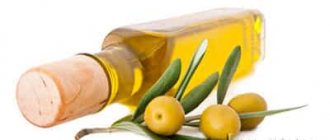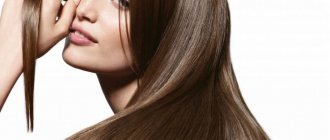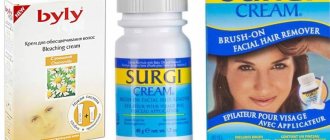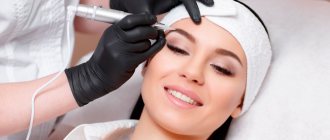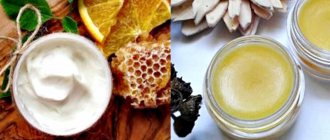Differences from painting with paint
Despite the fact that the technique is the same - the dye is applied to the eyebrows and washed off after a while, the difference between dye and henna is significant.
Eyebrow dye has a different composition (color base and developing emulsion), but it may contain oils, vitamins and other nourishing components - just like henna.
The paint provides a richer palette of shades - from light golden to black. Henna allows you to get only red-brown shades.
The paint is quickly washed off from the skin - in a few days, but remains on the eyebrow hairs for a long time. Henna colors both the hairs themselves and the skin underneath them, making it possible to better correct their shape.
In addition, only dye can lighten eyebrows. However, if we talk about the benefits, then it is henna that brings it, nourishing and restoring the eyebrows.
Henna for eyebrow biotattoo procedure
For many years, women in the East have been using this natural dye for cosmetic purposes.
However, only brown henna is suitable for changing the color of eyebrows. But to obtain the desired shade, additional components of plant origin are also used. For example, to get a rich black color, basma and henna are mixed in equal quantities; for a reddish, chestnut or other shade, lavsonia is used as a base and mixed with cocoa, ground coffee, infusion of walnut shells or its leaves.
If ready-made store-bought dyes are used, they will contain:
- ceaxanthin for hair nutrition;
- to strengthen routines;
- to prevent skin reactions, fisalenin, which also has an antimicrobial effect;
- betaine for moisturizing hair;
- emodinin to give a glossy shine;
- to stimulate hair growth, aloe-emodinin, which acts directly on the hair follicles;
- A natural dye with an anti-inflammatory effect is chrysophanol.
Advantages
- You can do it at home yourself.
- Suitable for girls under 18 years of age.
- Biotattooing does not cause any discomfort or pain.
- The procedure is not contraindicated for pregnant and lactating women.
- Biotattoo has almost no contraindications.
- The procedure allows you to model the desired eyebrow shape.
- After the procedure, eyebrows immediately look beautiful and natural.
- Natural ingredients are used, so biotattooing also nourishes and restores the eyebrows.
- If the coloring doesn't go well, it's easy to fix.
- Taking care of your eyebrows after the procedure is not too difficult.
Advantages of the method
In addition to its advantages, any cosmetic procedure also has some disadvantages. If we talk about eyebrow tattooing with henna at home, then it has only one significant disadvantage: the instability of the result. The effect lasts literally 2-3 weeks, after which the paint is evenly washed out of the skin and hairs, and after a month the next coloring is required.
For comparison: eyebrow tattooing using the hair method from a trusted professional in a salon will save you from the need for correction for at least six months, or even more. But this is a rather painful and expensive procedure.
The described method has many advantages:
- Henna is a natural plant dye that is harmless to the health and condition of the skin. Cases of allergies to eyebrow henna are extremely rare.
Iranian henna
- In addition to coloring, it also has healing properties , strengthening and healing hair.
- The procedure itself does not require piercing the skin or introducing dye into the epidermis layer , therefore it is not accompanied by painful sensations and complications in the form of irritation and inflammation.
- The price of herbal powder or ready-made henna dye compared to the cost of professional tattooing is simply not worth attention.
- And even the instability of the coloring result can be considered an advantage , since it allows you to often experiment with the shape and color of your eyebrows.
Flaws
- Without experience, it is difficult to choose a suitable and good paint, as well as apply it evenly to the eyebrows, making them symmetrical.
- The effect lasts for a relatively short time - about a month.
- Eyebrows may still require constant correction, such as plucking out excess hairs.
- Eyebrow shape correction is largely limited by their natural shape.
- In order for the effect to last longer, you need to constantly take care of your eyebrows and avoid peeling, saunas, steam baths and similar procedures.
- You may be allergic to henna.
How to properly care for eyebrows after henna dyeing?
To ensure that the dye lasts on your eyebrows as long as possible and does not require frequent corrections, you need to know some rules for caring for them after the biocoloring procedure.
It is important to remember that paint loses its properties as a result of frequent contact with water, which is why it is worth minimizing all water procedures. Ultraviolet rays have a negative effect on henna dye, which is why it is recommended to cover your eyebrows while sunbathing and visiting a solarium. After the biotattoo procedure, you should stop using peelings and scrubs, as well as other cleansers.
For more information about biotattooing eyebrows with henna and the procedure technique, see the following video instructions:
Tools and materials for the procedure
- makeup remover and skin cleanser;
- alcohol or alcohol wipes;
- henna for coloring;
- cosmetic brushes for applying paint (usually a thin, hard brush and brush);
- containers for mixing paint (glass or ceramic) and a stirring stick;
- white cosmetic pencil to draw outlines;
- templates for eyebrows, allowing you to give them the desired and symmetrical shape;
- cotton swabs and disks.
What is called biotattoo
Cosmetologists call biotattooing a type of permanent eyebrow tinting with special dyes based on natural henna. As a rule, brown henna is used for the procedure, which is selected taking into account the color type of the client’s appearance.
The peculiarity of biotattooing is that during the procedure the paint is applied from above to the skin, and not injected into the deep layers of the epidermis, as with conventional tattooing. Thanks to this, the procedure itself is painless; scars, swelling and other negative consequences of intervention in the body cannot appear after it.
The final result of henna tattooing can be seen and assessed immediately after the artist’s work is completed.
Eyebrow correction with this type of tattoo is performed as long as it takes time to draw the hairs. With proper care, the effect of biotattoo can last for 4-5 weeks. However, when visiting a bathhouse or using aggressive makeup removers, the intense color remains for up to 2 weeks, after which the eyebrows will need to be adjusted again.
To get the perfect result on your face, you should go to a salon.
It is advisable to perform biotattooing in a salon or in a cosmetologist's office. Those who have at least a little experience in eyebrow tinting can carry out this procedure on their own at home, this will make it easier to apply the dye evenly and create the correct eyebrow shape.
Which henna to choose?
Henna for eyebrows can be dry or ready-made, that is, liquid.
To color your eyebrows at home, it is better to choose ready-made henna and use trusted brands.
There are quite a lot of brands of henna, so it makes sense to consider the most popular ones.
- "Brow henna" . Considered the best. It is quite difficult to purchase this in stores, but you can order it online. Approximate price - 1000 rubles.
- "Nivali Brow " Does not cause allergies and has a pasty appearance. It is convenient to squeeze it out of a tube, which lasts for a long time (20-35 stains). Estimated price - 1100-1300 rubles.
- "Viva Henna " It has only one shade, but it is universal. Price - 200 rubles.
- "Artcolor" . One of the cheapest, Irish. Approximate price - 30 rubles.
- "Phytocosmetics" . Another cheap and affordable brand. Approximate price - 50 rubles.
Eyebrow dyeing with henna. Features, pros and cons of the procedure
Every year, the use of henna to color eyebrow arches is gaining more and more popularity. Its composition allows you to create a truly durable coating, and at the same time, does not have such unpleasant consequences as drying out the skin and deteriorating the structure of the hairs. The combination of effectiveness with complete safety of this vegetable dye is the reason for the gradual displacement of synthetic ones.
Henna dyeing is indicated for sparse eyebrows, with severe depletion of hairs damaged as a result of the action of aggressive dyes, with loss of color saturation and shine.
Advantages
In addition to the above advantages, this natural dye has a number of other important advantages:
- henna is ideal for restoring and creating a beautiful shape of eyebrow arches;
- with its help it is possible to achieve the smoothest possible transition of shades;
- due to its characteristics, henna does an excellent job of filling the “gaps” between hairs and enhancing the richness of their pigmentation;
- a huge assortment of shades makes it possible to choose the right tone for representatives of the fair sex of different types of appearance;
- complete safety in use;
- hypoallergenic;
- hair strengthening;
- caring effect;
- The durability of henna contributes to the long-term preservation of the achieved result.
You can dye your eyebrows with henna either by going to a beauty salon or carrying out the procedure yourself, following the instructions from the manufacturer.
How to care for eyebrows after henna dyeing?
The key points that daily eyebrow care should focus on are maintaining the neat shape and rich color of the hairs, as well as fully moisturizing the skin.
Care instructions:
- After the dyeing procedure, do not wet the hairs for two or three days, which will help better fix the pigment.
- Every two to three days you should inspect the eyebrow arches for the appearance of extra hairs that “stray” from the general line, and pluck them out with tweezers.
- Applying a mixture of various essential oils to the eyebrows has a very good caring effect. If the goal is to accelerate hair growth and increase their thickness, castor oil is used.
- Girls who are accustomed to using aggressive scrubs and peels for this area will have to give up this habit, since they contribute to the rapid leaching of pigment.
- You will also have to refrain from visiting the sauna, bathhouse, solarium, and swimming pools with chlorinated water.
Contraindications
Despite the fact that the procedure for tinting eyebrows with henna is characterized by maximum delicacy and safety, there are still a number of contraindications to its implementation.
These include:
- individual intolerance to one of the components of the coloring mixture;
- the presence of damage to the integrity of the skin, abrasions, scratches, wounds, etc.;
- inflammatory processes.
It should be noted that in the absence of the above contraindications, the procedure for tinting eyebrows with henna is not prohibited even for pregnant women.
How to wash off henna?
Girls just learning how to color their eyebrows with vegetable dyes on their own often encounter results that do not match the expected ones.
It will be possible to reduce the pigment saturation using the available means available in every home:
- Soak a cotton swab in hydrogen peroxide and gently wipe the eyebrow arches with it until the desired hair shade is achieved.
- Citric acid powder is diluted with water until the grains are completely dissolved, after which it is applied to the eyebrows and left to act for a couple of minutes, after which it is washed off with water at room temperature.
- Freshly squeezed lemon juice does an excellent job of lightening vegetable dyes.
- Actively wiping the eyebrow arches with a cotton swab soaked in olive oil can also help achieve the desired shade. To achieve the desired effect, the procedure is repeated many times throughout the day. After each application, wash off the oil with soapy water.
Careprost reviews
An integral condition for an attractive female image, along with clearly defined eyebrow arches, are dark thick eyelashes that serve as a frame for the eyes. They are able to enhance the expressiveness and depth of the gaze, emphasizing the size and shade of the eyes.
Currently, there are a lot of means and methods for dyeing eyelashes dark. Starting from decorative mascara, natural and synthetic dyes, and ending with a variety of salon procedures. But almost all of them are aimed only at achieving a luxurious visual effect, but if the goal is to strengthen and improve the condition of natural eyelashes, then special medicinal cosmeceuticals will come to the rescue. One of the best products on the market today is the innovative conditioner Careprost for eyelashes. Its amazing effectiveness is explained by its unique formula, the main component of which is the physiological fatty acid bimatoprost. It is present in small quantities in almost all cells of the human body and represents a high-quality “building material” for the development and growth of healthy and strong hairs.
Reviews of Careprost from representatives of the fair sex who have tested the effect of the drug on themselves confirm the effectiveness declared by the manufacturer, regardless of the initial condition of the eyelashes.
Daily application of the serum along the upper lash line allows you to achieve:
- enhancing their pigmentation;
- acquiring silkiness, elasticity and shine;
- accelerating growth;
- increasing length and thickness (up to 50%).
Careprost owners of naturally weak natural eyelashes or weakened due to unsuccessful extensions, diseases and other reasons. The product is completely safe and has no side effects. It can be used even by those with sensitive eyes, those who wear contact lenses, and girls prone to allergic reactions.
How to prepare for the procedure?
First you need to decide on the most suitable shade of paint and eyebrow shape.
If staining will be carried out for the first time, an allergy test should be done 48 hours before the procedure. To do this, you need to apply a little paint to the bend of your elbow and observe the reaction of the skin.
Immediately before the procedure, the skin should be cleansed. If it is not possible to do professional peeling, you can rub your eyebrows with a stiff brush to remove dead skin particles.
It is also necessary to thoroughly wash off all makeup and wipe your eyebrows with alcohol or an alcohol wipe.
Contraindications and disadvantages of biotattoo
Like any cosmetic procedure, biotattooing for eyebrows with henna has a number of disadvantages that you need to familiarize yourself with before coloring.
The first of them is personal intolerance to this natural component. Before tinting your eyebrows, you must do a test for an allergic reaction. Please note that biotattooing is strictly prohibited if there are minor cuts, scratches or abrasions. Getting henna on an open wound can cause discomfort. Recommends postponing coloring until the skin is completely healed.
The next disadvantage of this procedure is the need to keep the paint on the face for an hour. Ready-made synthetic formulations give results within 10 minutes after application. This won't work with henna. The dye must remain on the eyebrows for a long time to be effective.
Among the pronounced disadvantages of biotattooing, one should note the high probability of shedding or spreading of the composition. You can fix it by adding henna or water to the prepared composition.
How to choose the right color?
First of all, the color should be selected to match the shade of your hair. They should either be the same shade, or differ by 1-2 tones, no more. If your hair is dyed, you should focus on the hair color at the roots.
- Blondes will want shades that are slightly lighter than their base hair tone - for example, light brown.
- For owners of light brown hair, it is better to choose golden, brown, chestnut colors for eyebrows.
- Red-haired girls are better off choosing chocolate and chestnut shades of eyebrows.
- For brown-haired women, eyebrows are slightly lighter than their hair color - gray, brown.
- Brunettes should dye their eyebrows several shades darker than their hair color. But they should also focus on skin tone. The darker she is, the darker her eyebrows.
Henna for hair: benefits and harm
Henna has been used for hair coloring for a long time. Perhaps this is the very first hair dye in the world that has survived to this day unchanged. Its advantages are undeniable; no other modern dye will bring as many benefits to hair as henna.
Thanks to its antiseptic properties, henna is capable of fighting dandruff, fungus, as well as boils and herpes.
The tannins present in its composition have a positive effect not only on the hair itself, enveloping it and thereby protecting it from the negative effects of the external environment, but also on the skin under the hair.
The tannins present in its composition have a positive effect not only on the hair itself, enveloping it and thereby protecting it from the negative effects of the external environment, but also on the skin under the hair.
Henna has a warming effect, so it is recommended for use by those who often suffer from migraines.
So, the main advantages of natural henna:
- Colors hair without changing its structure.
- Gives hair a beautiful, deep and long-lasting color.
- Thanks to various natural additives, you can get a variety of shades: from bright red to copper and chestnut.
- Gives hair shine and smoothness.
- Protects hair from splitting and breakage.
- Strengthens hair follicles.
- Protects hair from loss.
- Helps get rid of dandruff.
- Suitable for oily hair.
- Makes hair thicker and more voluminous.
- Accelerates hair growth.
- Does not cause allergic reactions.
- It is much cheaper than chemical hair dyes.
But, like absolutely any product, henna for hair also has its disadvantages. Moreover, from a physiological point of view, henna cannot harm hair or health in general.
Henna practically does not stain gray hair.
Its disadvantages are purely aesthetic:
- Henna practically does not stain gray hair.
- Not suitable for dry hair types, as it dries out the hair (but if you add a little olive or burdock oil to the henna, this problem will be solved).
- Henna is not compatible with chemical hair dyes. If after henna you want to dye your hair with regular dye, you will have to wait at least six months until the henna is completely washed off from your hair.
- Conversely, if you apply henna to your hair after regular dye, the color may turn out green.
- You should not use henna more often than once a month, because more frequent use of henna violates hair protection.
- There is no point in dyeing your hair with henna after a perm, it will become straight.
- Henna strongly stains the skin, so it should be applied with gloves, and the hairline should be lubricated with a rich cream.
In general, henna for hair has more advantages than disadvantages, and its advantages over conventional dyes are even more obvious.
Therefore, if you prefer red-brown hair color, feel free to choose henna and get not only a beautiful color, but also healthy thick hair.
If you prefer red-brown hair color, feel free to choose henna and get not only a beautiful color, but also healthy thick hair.
Despite the fact that henna is an absolutely natural product , in rare cases it can cause allergies. An allergy to henna usually manifests itself in the form of redness, burning and swelling of the dyed area.
To eliminate a possible reaction, it is necessary to apply a small amount of henna to the inside of the wrist before first use. If after half an hour there are no negative skin changes, then henna is right for you.
You may also be interested in learning information on the topic: How to dye eyelashes with paint
Technique, stages and duration of the procedure
- Prepare and cleanse skin.
- Draw the contours of future eyebrows. This will make it easier and more convenient to draw them more evenly. To do this, you can use a stencil and a cosmetic pencil.
- Prepare the mixture and let it cool or take ready-made henna of the desired and suitable shade.
- Using a thin and stiff brush, draw the line of the eyebrows. In this case, you should first draw the tail of one eyebrow, then the other, then fill in the central parts of both eyebrows. It is better to paint the bases last. Depending on the desired shade, you can apply the paint in several layers.
- To make the color smoother, you can use a cotton swab: rub the edges of the eyebrows a little and remove some of the henna.
- You need to wait 20-50 minutes. The time depends on the desired shade and specific paint. Most often, on the packaging of henna they write how long it takes to keep this particular dye.
- Gently rinse off the henna with water. For a better effect, you can also use a brush to simply remove the layer of dried henna, and then brush off its grains from the entire face with a soft brush.
The duration of the procedure depends on the woman’s experience and skills. The first biotattoo procedure will most likely take a lot of time, but gradually it will be required less and less.
The video shows in detail the process of tinting your eyebrows yourself at home.
Types of henna for tinting eyebrows at home
To carry out the procedure of bio-coloring of eyebrows, three main types of paint from lavsonia are used - Indian, Iranian, Sudanese.
Colorless henna is the most popular, but it does not have the necessary coloring properties. But thanks to its use, the hair becomes healthier, stronger and significantly improves its condition. Today, henna for bio-coloring eyebrows is not uncommon. Therefore, you can purchase this product in almost any cosmetic store or on a specialized website at a very affordable price. It is important to choose the right shade of paint, and for this you will need to read the information included with the dye or consult a professional cosmetologist.
Biotattooing is one of the simplest and most affordable ways to give your eyebrows the desired shade and well-groomed appearance. However, the main disadvantage is the short-term nature and unstable results.
If you plan to color your eyebrows yourself using simple henna powder in combination with other coloring additives, then coloring will need to be done once every 10 days. Provided that the procedure is carried out by an experienced master using a professional paint composition, the result will last approximately 1–1.5 months.
Eyebrow cream-henna “PhytoCosmetic”
Today, there are several of the most famous and popular manufacturers of ready-made henna for eyebrows. One of them is the Belarusian brand “FitoCosmetic”.
This brand produces several different henna-based lines not only for eyebrows, but also for hair and even eyelashes. This includes ready-made henna cream, hair masks, and tinted balms.
Cream-henna for eyebrows and eyelashes “PhytoCosmetic” is a ready-to-use mixture with a natural composition without ammonia and hydrogen peroxide.
Today, there are several of the most famous and popular manufacturers of ready-made henna for eyebrows. One of them is “PhytoCosmetic”.
Sold in cardboard packages with two 2 ml sachets and an insert with a description of the product. One sachet is designed for one use.
The consistency of the mixture is thick, creamy, spreads easily and does not spread, and has a faint smell of henna. Easily corrected with a cotton swab dipped in water. Presented in several natural noble shades from light brown to black.
Keep the henna cream “PhytoCosmetic” on the eyebrows for 20-25 minutes , but it can be longer, then rinse with warm water. This henna is easily washed off without staining the skin.
Eyebrow cream-henna “PhytoCosmetic” does not cause allergic reactions or discomfort, and also has a very affordable price - only 55 rubles per package.
How to extend the effect?
How long does henna last? This depends not only on the quality of the work performed, the shelf life of the composition and proper care, but also on the type of skin. For example, on dry skin the pigment lasts up to 4-5 weeks, while on oily skin it lasts only up to 2.5. To extend these periods, you need to have your eyebrows tinted with henna from good professionals. Of course, you can try to repeat it yourself, but all the subtleties and nuances of this procedure are known only to an eyebrow artist. The second important condition is the use of professional henna. For coloring you will need a special brown powder. Henna is not suitable for hair - it gives a red color. And lastly, for the color to be permanent, prepare the eyebrow area. To do this, on the day of painting, clean your skin with a scrub (store-bought or homemade).
Aftercare for hennaed eyebrows
In order for colored eyebrows to delight you with their beauty for as long as possible, you need to properly care for them. After all, as a result of mistakes made during maintenance, the paint will be removed within 10–14 days.
Water and places of high humidity have a detrimental effect on henna. Try not to get your eyebrows wet the first day after coloring. After all, pigment absorption continues to occur for another day after painting. And in the following days, wet them with water as little as possible. It is especially undesirable to get cosmetics on them: scrubs, makeup remover, tonic. If possible, avoid visiting the bathhouse and sauna, and dive into the sea less.
When going outside on hot sunny days, try to cover your eyebrows from scorching UV rays. When visiting a solarium, apply special stickers to them so that the henna does not change color.
To maintain the effect, a couple of times a week you can make a nourishing mask of wax, linseed oil and Vaseline, mixed in equal proportions. Keep this mask for about 10 minutes. And in the morning and evening, lubricate your eyebrows with any oil available to you - olive, sunflower, castor.
How to dilute and how long to keep henna for eyebrows
To dilute henna, you should use boiled water cooled to 70 degrees. You need to add enough water to get a porridge-like mixture with a fairly thick consistency.
If the mixture is too liquid, it will flow from the eyebrows and stain the entire face. In addition, the liquid mass colors less intensely. The coloring properties of henna are better manifested in an acidic environment , so it is advisable to add 1-2 teaspoons of lemon juice to the prepared mixture.
To obtain a specific shade, different products are added to henna. Most often it is basma. Different proportions of henna and basma give many beautiful and natural colors. If you mix one part henna and one part basma, the color will be black.
Chestnut color can be obtained by mixing henna and basma in a ratio of 3 to 1. Chocolate color is obtained from tincture of walnut shells and coffee. By experimenting with different additives, you can change the color of your eyebrows and still look natural.
To obtain a specific shade, different products are added to henna.
To achieve maximum effect, henna should be kept on the eyebrows until completely dry. This usually takes about an hour.
However, if you are performing the coloring procedure for the first time, it is better to limit it to 30 minutes to avoid the consequences of incorrect application.
When you have fully mastered the technique of biotattooing eyebrows with henna, you can slightly extend the time of direct contact of henna with the hairs to obtain a more saturated color and lasting result. It will last longer and the reviews from those around you will impress you.
Customer opinions
In general, reviews of the use of henna eyebrow biotattooing are positive. Almost all users note an improvement in the condition of the hairs, their healthier and brighter appearance. After dyeing your eyebrows with henna, they become thicker , and their color becomes richer and deeper.
After dyeing your eyebrows with henna, they become thicker, and their color becomes richer and deeper.
Rare exceptions are individual intolerance to henna for eyebrows or its improper use.
Recently, biotattooing of eyebrows with henna has become an increasingly popular means. And this happens thanks to the unique properties of henna not only to dye, but also to heal hair and eyebrows.
In terms of the effect produced, biotattooing looks the same as regular permanent tattooing , but not with such a long-lasting effect. And this is perhaps the only disadvantage of biocoloring.
In fact, the benefits of eyebrow biotattooing may be even greater than you think.
In terms of the effect produced, biotattooing looks the same as regular permanent tattooing, but not with such a long-lasting effect.
The absence of allergic reactions, the painlessness of the procedure, the ease of correcting unsuccessful application, the possibility of carrying out the procedure at home, the improvement of hairs, the price accessible to almost any woman - all these are trump cards that no salon eyebrow tinting technology can boast of.
This video will give you the opportunity to see how biotattooing of eyebrows with henna is carried out by a cosmetologist.
From this video you will learn how to properly color your eyebrows with henna so that they are perfect.
In this video you will see how to perform eyebrow correction.


